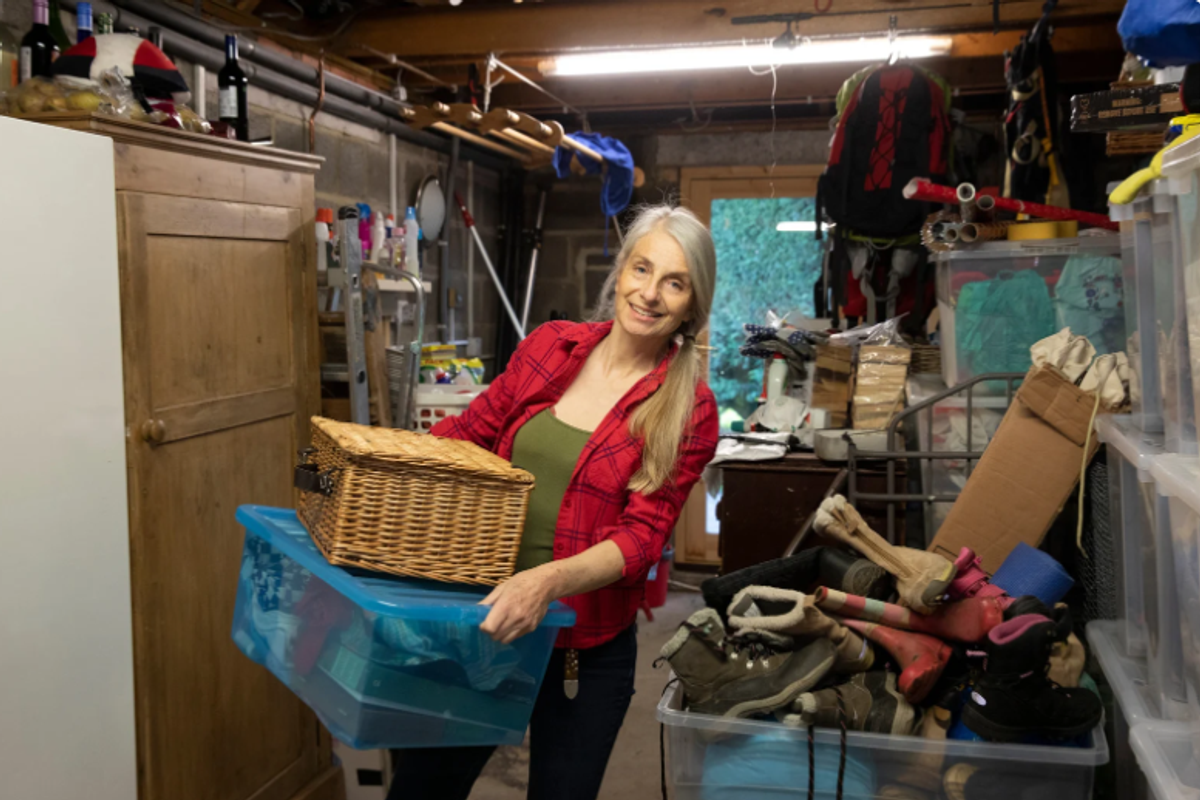As winter rolls along, it's important for everyone to stay warm.
Throughout this season, much of the United States has been buried under "crippling" amounts of snow and ice.
Meteorologist Louis Uccellini showing how little chance we have of escaping winter. Photo by Alex Wong/Getty Images.
So when one of those storms hits, stock up on hot chocolate, get under a blanket, and get ready to wait it out while you finally catch up on "Mad Men" (seriously, it ended ages ago what are you doing with your life?).
Just remember, while you're wrapped up all cozy and planning your best snowstorm Instagram post, there are other creatures out there who need to stay warm too.
Here are some things you can do to help your pets and other animals survive yet another winter wonderland.
1. Keep your pets indoors as much as possible.
The quickest, easiest way to make sure your pets are safe and warm during wintry weather is to keep them inside.
Outdoor cats will throw you some serious shade, and you'll obviously still have to walk your dog, but make sure all members of your family are inside while the worst of the winter apocalypse bellows through.
"Do ... do you think it's like this on the other side of the house?" Photo via iStock.
2. Dog sweaters! They're cute AND practical.
Who doesn't love a dog in a sweater? If a dog in a sweater were president, there'd be no more war. That's just a fact. Besides being adorable, dressing your dog up a little for their walk helps them avoid injury and hypothermia. Not to mention, it's just not fair for you to put on seven layers of clothing and then march your dog outside naked.
Short-haired dogs are especially sensitive to cold air, and wind chill can cause frostbite, which can lead to permanent damage. So dress your pup up beforehand.
This knitted pullover is perfect for all pup-ccasions, both casual and formal. Don't be caught playing dead without this chic little number. Photo by Odd Andersen/AFP/Getty Images
3. Build an outdoor shelter for your pet.
If your pet spends most of their time outside and simply can't stand the thought of staying indoors all day, its important to have a winter-proof outdoor shelter for them.
Make sure it's dry and big enough for your pet to lie down comfortably. Also make sure it's raised a few inches above the ground for protection from the snow.
4. Don't forget about the stray cats in your neighborhood.
It's always a good idea to keep an eye out for neighborhood cats that spend most of their time outside. They may be feral or owned and just wandering.
If you see one, and can do so, offer them shelter in your home (if you have a screened-in porch and a box and some blankets, or even just a box and some towels to put out for them) and some food and water.
Stray cats may talk big, but even they can't entirely fend for themselves in winter storms.
"I'm not kidding, Steve. Tell them to let us in." "I'm barking, Marge. Don't you see me barking?!" Photo by Justin Tallis/AFP/Getty Images.
5. If you're driving anywhere, check under the hood of your car before you turn it on.
Your car's engine is a warm, dry place where small animals might seek shelter. Small cats, chipmunks, and squirrels have been known to crawl up under the hoods of cars and fall asleep while checking your oil.
To avoid hurting them, check under your hood and bang around a bit to scare them off before starting the car.
"Your PSI is a little low. Also your rear taillight is broken. I'll let you off with a warning." Photo via iStock.
6. Protect your dog's paws from salt.
The salt used to melt ice and snow can be harmful to your pets. If it gets on their paws, it might sting, and if they attempt to lick it off, it can be dangerous if ingested.
Make sure you wipe your pet's paws with a damp towel if they've been around salt.
Booties can also protect your dogs paws, with the advantage of being cute as hell. Plus you get to say the word "booty" as much as you want. Photo by David Hecker/AFP/Getty Images.
7. Build a brush pile for wild animals to shelter in.
If you have a yard that isn't buried in snow yet, get out there and build a brush pile out of leaves and sticks. Believe it or not, small animals and insects will find it and use it as shelter from the cold.
Think about it this way: Your lawn is a place where trees and bushes used to be. So when the snow comes, the animals in the area have fewer places to take refuge. Help them out by giving them a little bit of nature back.
See how stressed he is? Photo via iStock.
8. You may need to feed your pet more food than usual.
Of course your pets always need food and water, but in the winter when it's cold, they'll burn more calories to stay warm.
Keep them well fed and hydrated and they'll be a lot more comfortable.
"So he started drinking and before you know it, there was potato salad everywhere. I knew we shouldn't have invited him." Photo by Frederick Florin/AFP/Getty Images.
9. Provide water for wild animals whose usual water source may have frozen over.
Making sure your own pets have water during the storm is important, but it's also a good idea to have a fresh water source outside for other animals.
When it's freezing, water will ... well you know. This leaves birds and small creatures with much fewer reliable sources of water. Putting a water source outside with a safe heating element to make sure it doesn't freeze will save local animals a lot of grief.
"I swear there was a pond here two days ago." "Yeah well it's not here NOW, IS IT, TERRY?" Photo via iStock.
10. Always buy nontoxic antifreeze.
Antifreeze has a sweet smell and taste that can be very attractive to animals, especially hungry animals looking to escape the cold. However, it's highly poisonous if consumed, so buying a nontoxic brand is an easy way to make sure it won't harm a creature who just wanted a nice dinner.
You can also buy antifreeze with "denatonium benzoate" — a bittering agent that won't attract wildlife.
Looks like liquid bubblegum. Tastes like liquid poison. Photo via iStock.
11. Dry your pets off when they come in from outside.
Keeping your pet dry is a key way to make sure they don't freeze — especially after a long walk or when they come inside. When you and your dog come back from a walk or a quick run through the snow, dry them off with a towel and get all the snow out from between their toes.
You wouldn't want to be soaking wet in the freezing cold. Your pets probably don't like it either.
"This displeases me. My dad is the president. I shouldn't have to deal with this." Photo by Mandel Ngan/AFP/Getty Images.
12. Let your pet's fur grow out for the winter.
If you regularly shave or cut your dog's hair, let them go au natural during the winter. It will help them stay insulated and warm. Plus, exposed skin on an animal can increase its chances of frostbite and hypothermia.
They call him Mr. Boombastic. Get it? Shaggy? Photo via iStock.
13. Combat your pet's skin's dryness with a humidifier.
If your pet is regularly coming in from the cold snow to your dry, heated home, they might get dry skin, which can be very irritating and cause a lot of discomfort.
A good way to combat against this is to keep a humidifier in your home. Just like you do for your own skin.
Steam: air with gravitas. Photo via iStock.
14. Regular grooming year-round can help when a winter storm hits.
Believe it or not, regularly brushing your pets and keeping them groomed can help keep them safe come blizzard time.
Brushing improves circulation, which helps keep them warm and combats the aforementioned skin dryness (in case you don't have a humidifier on hand) — not to mention that healthy clean fur helps your pets insulate better, which keeps them nice and toasty.
Fab. You. Lusssss. Photo by Hendrik Schmidt/AFP/Getty Images.
15. Don't leave your pets alone if you're traveling.
This might seem like an obvious one, but if it's below freezing, you really shouldn't leave your pets alone in the house while you ski for a week. Either take your pet with you or have someone else take care of them.
A pet left alone in a freezing house is susceptible to hypothermia and could freeze to death.
I swear I passed that tree before. Photo via iStock.
16. If you do brave the snow for a w-a-l-k, keep your dog on a leash.
Dogs rely on scents to help them get around — but when the ground is covered in snow, they can lose those familiar scents and are more likely to get lost.
When you take your dog for a walk, keep it business-only and don't let them wander too far away.
Wow. Much snow. Very winter. Photo by Patrick Domingo/AFP/Getty Images.
Finally. And most importantly:
17. Speak out if you see a pet left outside.
No pet deserves to be left out in the cold. If you see one, let their owner know that you're concerned. If nothing changes, get proactive and report it to your local animal control agency or the police. Document the date, time, and location and take pictures. Make no mistake: Animal abuse is a crime.
Don't be afraid to call 911 if that's your only option.
Winter can be tough for everyone. The best way to think about taking care of animals is this: Don't let your animal be subjected to anything you wouldn't want to be subjected to yourself.
You wouldn't go outside without a coat on, so don't let your dog. You wouldn't want all your water sources to freeze over, so don't let it happen to animals.
You have the luxury of a heated home and reliable food. Other animals might not have that, so once you've got your winter storm prep down, take a second to think about them.
For more information on how you can help animals during the winter, check out the Humane Society website as well as the ASPCA.
- Once a year, capybaras at this Japanese zoo are treated to a fully immersive spa day - Upworthy ›
- Once a year, capybaras at this Japanese zoo are treated to a fully immersive spa day - Upworthy ›
- Pub owner finds a seal at his front door - Upworthy ›
- Popular veterinarian Dr. Lisa Lippman shares 5 tips to help you and your dog thrive this holiday season - Upworthy ›
- Whoever is naming the cats at this Austin shelter probably needs to be drug tested. - Upworthy ›



 Stayin Alive GIF by Bee Gees
Stayin Alive GIF by Bee Gees 





 The Himakajima traffic light.via
The Himakajima traffic light.via